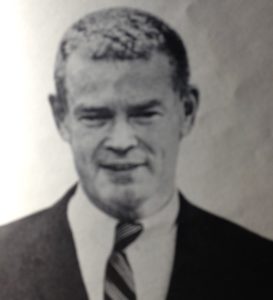Richard Graham, Deputy Associate Director for Public Affairs
 His own flourishing electronics company handled such fascinating assignments as the design and construction of the atomic reactor controls for the first atom-powered U.S. merchant ship, the Savannah. For Dick Graham personally it was probably just as important that the firm offered him a constructive outlet for his skills as a high lever tinkerer.
His own flourishing electronics company handled such fascinating assignments as the design and construction of the atomic reactor controls for the first atom-powered U.S. merchant ship, the Savannah. For Dick Graham personally it was probably just as important that the firm offered him a constructive outlet for his skills as a high lever tinkerer.
From atomic controls engineering to Peace Corps recruiting might seem as first glance to compose a disconnected journey. Not so, Graham insists, explaining that the nature of his duties with his company made his transition to the Peace Corps perfectly natural. “I was my own advertising manager—writing releases, holding sales meetings, editing the house organ—all the kinds of things one does in recruiting.”
Here in Washington, he admits to “no regrets about leaving the company,” and insists that he doesn’t want to “hear any nonsense about financial sacrifice. In the Peace Corps, I am doing exactly what I want to do.”
Born in Chicago and raised in Milwaukee, Graham received his Bachelor of Mechanical Engineering degree from Cornell University in 1942—just in time to sign with the Army as an ordnance officer. His heavy automotive maintenance battalion was shipped to Andimesk in the Zagros Mountains of Iran, on one of the chief American supply routes to Russia.
At Depot Utilities Officer, Graham set to work constructing roads and buildings and installing power and water systems. Returned to the United States he went through flight training and was named project officer to a guided missile program involving the launching of buzz bombs from aircraft. Before his discharge in 1946, he also worked at the design and testing of a ground-to-ground missile system.
 After the war, Graham joined the Graham Transmission Company, a Milwaukee firm founded by his father. Besides serving as sales manager, he took on the design of a variable-speed drive system which, in the years since, has come to be used in everything from food processing and printing machinery to mechanical hearts.
After the war, Graham joined the Graham Transmission Company, a Milwaukee firm founded by his father. Besides serving as sales manager, he took on the design of a variable-speed drive system which, in the years since, has come to be used in everything from food processing and printing machinery to mechanical hearts.
Five years ago, he organized his own company, Jordan Controls Inc., with Charles Jordan as his partner. The company’s bread–and-butter output consisted of positioning controls, but Graham didn’t hesitate to jump into jobs “that were just fun—without much money in them.”
The building of the reactor controls for the Savannah was a typical non-lucrative challenge. Another was the construction of a control system which would enable one computer to build another. At the same time, Graham’s constant tinkering led to a number of patents which he still holds—on such things as a “digital comparator” for refinery control and various devices for vending hot food.
His outside hours were taken up in part as a leader of a Great Books group and, briefly, as chairman of his local school board. He is also an ardent skier.
Despite his absorption in technology, Graham kept a persistent eye on world affairs, and his views were shaped with the help of several trips to Europe and one trip around the world. When the Peace Corps was announced, he saw in the new agency an opportunity for “service of a kind I had been hoping for for years.” Married to the former Nancy Aring of Wanwatosa, Wis., he is the father of three boys and two girls. He is one of two staff members (the other—Chief Counsel William Delano) who commutes to Georgetown daily on a bicycle.
“Just one year old
this month, the Peace
Corps is by far the
bounciest and most
promising baby yet
spawned on the
New Frontier.”
–Radio newscaster
Edward P. Morgan
No comments yet.
Add your comment